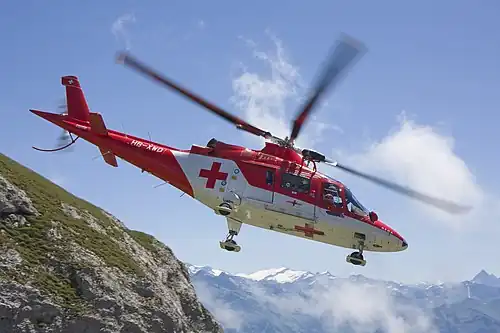| Ingenuity | |
|---|---|
| Part of Mars 2020 | |
 Ingenuity on April 6, 2021, its third day of deployment | |
| Type | Extraterrestrial autonomous UAV helicopter |
| Serial no. | IGY (civil registration) |
| Owner | NASA |
| Manufacturer | Jet Propulsion Laboratory |
| Specifications | |
| Dimensions | 121 cm × 49 cm × 52 cm (48 in × 19 in × 20 in) |
| Dry mass | 1.8 kilograms (4.0 lb)[1] |
| Communication | Zigbee transponder with base station on Perseverance |
| Power | 6 Solar-charged Sony VTC-4 Li ion batteries; typical engine input power: 350 watt[2] |
| Instruments | |
| |
| History | |
| Deployed |
|
| Location | Jezero crater, Mars[3] |
| First flight |
|
| Last flight |
|
| Flights | 71 |
| Flight time | 2 hr 8 min 18 sec, cumulative |
| Travelled |
Data from NASA Mars Helicopter Flight Log
|
| NASA Mars helicopters | |
Ingenuity, nicknamed Ginny, is a small autonomous helicopter presently operating on the planet Mars. It is part of NASA's Mars 2020 mission. The helicopter arrived on the Martian surface attached to the underside of the Perseverance rover, which landed on February 18, 2021. The helicopter was deployed to the surface on April 3, 2021.[4][5] Both the rover and the helicopter began their missions on Mars at the Octavia E. Butler Landing site near the western rim of the 28 mi (45 km) wide Jezero crater.[6][7][8]
On April 19 it made the first powered, controlled extraterrestrial flight by any aircraft. During its first flight Ingenuity took off vertically, hovered, and then landed. It flew for a total of 39.1 seconds during that attempt.[9][10][11] As of its 71st flight on January 6, 2024 (UTC), Ingenuity had flown a total of two hours, eight minutes and eighteen seconds in 992 days.[12]
The flights have demonstrated the helicopter's ability to fly in the extremely thin atmosphere of Mars, just 0.6% as thick as the air on Earth. It proved that flight was possible on other planets without the direct human control that the finite speed of light makes impractical (depending on the positions of the two planets, radio signals take between 5 and 20 minutes to travel between the Earth and Mars).[13] As a result of this delay Ingenuity must autonomously perform the maneuvers planned, scripted and transmitted to it by its operators.
The helicopter was intended to perform a 30-sol technology demonstration, making five flights at altitudes ranging from 3–5 m (10–16 ft) for up to 90 seconds each.[1][14] Before Ingenuity's first flight, Perseverance drove approximately 100 m (330 ft) away to create a safety buffer between itself and the helicopter.[15][16] The success of Ingenuity's first flight was confirmed three hours after its completion by JPL, which livestreamed a view of mission control receiving the data.[17][18][19] On April 30, 2021, during its fourth flight, Perseverance recorded the sound of Ingenuity during operation, making it the first interplanetary spacecraft whose sound was recorded in situ by another interplanetary spacecraft.[20]
After a brief demonstration phase to prove its airworthiness, JPL commenced a series of flights designed to show how aerial scouting could aid the exploration of Mars and other worlds.[21][22] In this operational role Ingenuity now scouts areas of interest for the Perseverance rover.[23][24][1][25]
The helicopter's performance and resilience in the harsh Martian environment have greatly exceeded expectations. The aircraft surpassed its required altitude and flight duration specifications soon after beginning operations on Mars. This allowed Ingenuity to perform far more flights than were initially expected of the aircraft. It flew during the remainder of 2021 and into 2022. In March 2022 NASA announced that it would extend Ingenuity's mission and continue to fly the aircraft through at least September of that year.[26] As of January 2024 it continues to perform successful flights, providing images for scientific study and site scouting for Perseverance.
Ingenuity was designed by NASA's Jet Propulsion Laboratory (JPL) in collaboration with AeroVironment, NASA's Ames Research Center and Langley Research Center.[27] Contributors of key components included Lockheed Martin Space, Qualcomm, and SolAero.[28]
Development
Concept

The development of the project that would eventually become Ingenuity started in 2012 when JPL director Charles Elachi toured and met with members of the Autonomous Systems Division at JPL. The idea for the project drew on prior concept work in the division. By January 2015, NASA agreed to fund the development of a full-size model, which came to be known as the "risk reduction" vehicle.[29] NASA's JPL and AeroVironment published the conceptual design in 2014 for a scout helicopter to accompany a rover.[27][30][31] By mid-2016, $15 million was being requested to continue development of the helicopter.[32] By December 2017, engineering models of the vehicle had been tested in a simulated martian atmosphere[25][33] and models were undergoing testing in the Arctic, but its inclusion in the mission had not yet been approved or funded.[34]
Mission integration
At the time of the approval of the Mars 2020 program in July 2014,[35] a helicopter flight demonstration was neither scoped nor budgeted.[36]
The United States federal budget, announced in March 2018, provided $23 million for the helicopter for one year,[37][38] and it was announced on May 11, 2018, that the helicopter could be developed and tested in time to be included in the Mars 2020 mission.[39] The helicopter underwent extensive flight-dynamics and environment testing,[25][40] and was mounted on the underside of the Perseverance rover in August 2019.[41] NASA spent about $80 million to build Ingenuity and about $5 million to operate the helicopter.[42]
In 2019, preliminary designs of Ingenuity were tested on Earth in simulated Mars atmospheric and gravity conditions. For flight testing, a large vacuum chamber was used to simulate the very low pressure of the atmosphere of Mars – filled with carbon dioxide to approximately 0.60% (about 1⁄160) of standard atmospheric pressure at sea level on Earth – which is roughly equivalent to a helicopter flying at 34,000 m (112,000 ft) altitude in the atmosphere of Earth. In order to simulate the much-reduced gravity field of Mars (38% of Earth's), 62% of Earth's gravity was offset by a line pulling upwards during flight tests.[43] A "wind-wall" consisting of almost 900 computer fans was used to provide wind in the chamber. [44][45]: 1:08:05–1:08:40
In April 2020, the vehicle was named Ingenuity by Vaneeza Rupani, a girl in the 11th grade at Tuscaloosa County High School in Northport, Alabama, who submitted an essay into NASA's "Name the Rover" contest.[46][47] Known in planning stages as the Mars Helicopter Scout,[48] or simply the Mars Helicopter,[49] the nickname Ginny later entered use in parallel to the parent rover Perseverance being affectionately referred to as Percy.[50] Its full-scale engineering model for testing on Earth - Earth Copter and unofficially Terry.[51]
Ingenuity was designed to be a technology demonstrator by JPL to assess whether such a vehicle could fly safely. Before it was built, launched and landed, scientists and managers expressed hope that helicopters could provide better mapping and guidance that would give future mission controllers more information to help with travel routes, planning, and hazard avoidance.[39][52][53] Based on the performance of previous rovers through Curiosity, it was assumed that such aerial scouting might enable future rovers to safely drive up to three times as far per sol.[54][55] However, the new AutoNav capability of Perseverance significantly reduced this advantage, allowing the rover to cover more than 100 meters per sol.[56]
Development team
.jpg.webp)
The Ingenuity team was comparatively small, with never more than 65 full-time-equivalent employees from JPL. Program workers from AeroVironment, NASA AMES and Langley research centers brought the total to 150.[29] Key personnel include:
- MiMi Aung – Ingenuity Mars Helicopter Project Manager at NASA's Jet Propulsion Laboratory,[57][58][59][29]
- Bob Balaram – Chief Engineer (prior to Nov 2021)[60][61][62][63]
- Timothy Canham – Flight Software Lead and Operations Lead (prior to June 2021)[64][65][66]
- Håvard Fjær Grip – GNC Lead and Chief Pilot[67][68][69][63][70][71]
- Matt Keennon – AeroVironment Technical Lead [31]
- Ben Pipenberg – AeroVironment Design Lead [31]
- Josh Ravich – Mechanical Engineering Lead[72][73]
- Teddy Tzanetos – Operations Lead[74][75][71]
- Nacer Chahat – Antenna Engineer and Telecom System Engineering [76][77][78]
On June 15, 2021, the team behind Ingenuity was named the 2021 winner of the John L. "Jack" Swigert Jr. Award for Space Exploration from the Space Foundation.[79] On April 5, 2022, the National Aeronautic Association awarded Ingenuity and its group in JPL the 2021 Collier Trophy.[80][81]
Opposition to the helicopter
The idea to add a helicopter to a Mars mission was opposed by multiple people. Up until the end of the 2010s, several NASA leaders, scientists and JPL employees actively put forward counterarguments against the integration of a helicopter into the next expedition. For three years, the future Ingenuity has been developed outside the Mars 2020 project and its budget.[14][82] When NASA management accepted assurances in the spring of 2018 that the addition of a helicopter would not harm the goals of the expedition, the chief scientist of this project[83] Kenneth Farley stated that it does not follow from the fact that Ingenuity was taken on board that the team supported this decision even with guarantees of no risk.[84] Farley was convinced that the helicopter was a distraction of a group of scientists from a priority scientific task, unacceptable even for a short time.[84]

The skepticism on the part of NASA leadership was not unfounded. Scientists, engineers and managers proceeded from a pragmatic comparison of the benefits of additional aerial reconnaissance with the costs that inevitably fall on the schedule for the rover to complete all the tasks assigned to it. Arguing with MiMi Aung on the air of a joint conference, Jennifer Trosper warned that thanks to auto-navigation, the rover ultimately outpaces the helicopter. These calculations were first confirmed in the spring of 2022 when by the beginning of Sol 400 the helicopter did not take a leading position on the track along the slopes of the delta, although it covered a distance several times less than the rover. Due to the increased loss of time for recharging and transmitting telemetry, the attempt to bring the helicopter to the position of the route plotter, planned during the ascent to the delta, also failed.[85]
At the end of the "test window", NASA extended support for Ingenuity for another 30 sols, limiting the frequency of departures to one flight every few weeks. Later on, some of NASA's senior leaders seized the opportunity to dampen their enthusiasm for the Martian helicopter. Thus, addressing directly all the staff of the Mars 2020 project, the director of the Mars exploration program E. Janson and the principal Mars explorer M. Meyer urged the staff to “be highly disciplined and concentrate on collecting samples”.[86] At the same time, in their report to the Planetary Advisory Committee (PAC) on June 14, 2021, the helicopter was mentioned only in the past tense: "placed Ingenuity and completed the technology demonstration phase".[86]
Despite this early pessimism, Ingenuity has since proved to be more than capable of keeping up with Perseverance, actually staying ahead of the rover for the majority of the traverse up the Jezero delta.[87] Insufficient solar energy during the Martian winter was the main driver of poor operational performance in the latter half of 2022.[88]
Design
Mechanical design
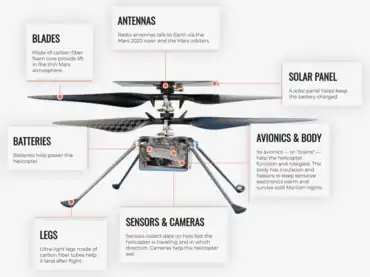
Ingenuity consists of a rectangular fuselage measuring 136 mm × 195 mm × 163 mm (5.4 in × 7.7 in × 6.4 in) suspended below a pair of coaxial counter-rotating rotors measuring 1.21 m (4 ft) in diameter.[1][33][49] This assembly is supported by four landing legs of 384 mm (15.1 in) each.[1] It also carries a solar array mounted above the rotors to recharge its batteries. The entire vehicle is 0.49 m (1 ft 7 in) tall.[1]
.png.webp)
The lower gravity of Mars (about a third of Earth's) only partially offsets the thinness of the 95% carbon dioxide atmosphere of Mars,[89] making it much harder for an aircraft to generate adequate lift. The planet's atmospheric density is about 1⁄100 that of Earth's at sea level, or about the same as 87,000 ft (27,000 m), an altitude never reached by existing helicopters. This density reduces even more in Martian winters. To keep Ingenuity aloft, its specially shaped blades of enlarged size must rotate between 2400 and 2900 rpm, or about 10 times faster[33] than what is needed on Earth.[90][91] Each of the helicopter's contra-rotating coaxial rotors are controlled by a separate swashplate that can affect both collective and cyclic pitch.[92] Although it is an aircraft, it was constructed to spacecraft specifications to endure the acceleration and vibrations during launch.[91]
Avionics
Ingenuity relies on different sensor packages grouped in two assemblies. All sensors are commercial off-the-shelf units.

The Upper Sensor Assembly, with associated vibration isolation elements, is mounted on the mast close to the vehicle's center-of-mass to minimize the effects of angular rates and accelerations. It consists of a cellphone-grade Bosch BMI-160 Inertial measurement unit (IMU); and an inclinometer (Murata SCA100T-D02), which is used only on the ground prior to flight to calibrate the IMU accelerometers biases. The Lower Sensor Assembly consists of an altimeter (Garmin LIDAR Lite v3), cameras, and a secondary IMU, all mounted directly on the Electronics Core Module (not on the mast).

Ingenuity uses a 425×165 mm solar panel to recharge its batteries, which are six Sony Li-ion cells with 35–40 Wh (130–140 kJ) of energy capacity[43] (nameplate capacity of 2 Ah).[25] Flight duration is not constrained by the available power, but by the motors heating up 1 °C every second.[93] The helicopter uses a Qualcomm Snapdragon 801 processor with a Linux operating system.[64] Among other functions, it controls the visual navigation algorithm via a velocity estimate derived from terrain features tracked with the navigation camera.[94] The Qualcomm processor is connected to two radiation-resistant flight-control microcontroller units (MCUs) to perform necessary control functions under Mars's conditions.[25]
The telecommunication system consists of two identical radios with monopole antennae for data exchange between the helicopter and rover. The radio link utilizes the low-power Zigbee communication protocols, implemented via 914 MHz SiFlex 02 chipsets mounted in both vehicles. The communication system is designed to relay data at 250 kbit/s over distances of up to 1,000 m (3,300 ft).[76] The antenna on the helicopter's solar panel weighs 4 grams and can communicate equally in all directions.[95]
Cameras and photography
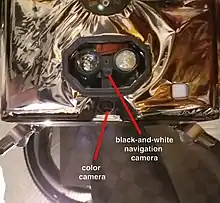
Ingenuity is equipped with two commercial-off-the-shelf (COTS) cameras: a high-resolution Return to Earth (RTE) camera and a lower resolution navigation (NAV) camera. The RTE camera consists of the Sony IMX 214, a rolling shutter, 4208 × 3120-pixel resolution color sensor, fitted with a Bayer color filter array and an O-film optics module. The NAV camera consists of an Omnivision OV7251, a 640 × 480 black and white global shutter sensor, mounted to a Sunny optics module.[25]
Unlike Perseverance, Ingenuity does not have a special stereo camera for taking twin photos for 3D pictures simultaneously. However, the helicopter can make such images by taking duplicate color photos of the same terrain while hovering in slightly offset positions, as in flight 11, or by taking an offset picture on the return leg of a roundtrip flight, as in flight 12.[96]
.jpg.webp)
While the RTE color camera is not necessary for flights (as in flights 7 and 8[74]), the NAV camera operates continuously throughout each flight, with the captured images used for visual odometry to determine the aircraft's position and motion during flight. Due to limitations on the transmission rate between the aircraft, the rover, and Earth, only a limited number of images can be saved from each flight. Images to save for transmission are defined by the flight plan prior to each flight, and the remaining images from the NAV camera are discarded after use.
As of December 16, 2021, 2091 black-and-white images from the navigation camera[97] and 104 color images from the terrain camera (RTE)[98] have been published.
| Flight No. | Date (UTC) and Mars 2020 mission sol | Photographs | Comments | |
|---|---|---|---|---|
| b/w NAV |
color RTE | |||
| Before April 19, 2021 (sol 58) | 6[99] | 6[100] | Preflight camera tests | |
| 1 | April 19, 2021 (sol 58) | 15 | — | |
| 2 | April 22, 2021 (sol 61) | 17 | 3 | The first color photo session |
| 3 | April 25, 2021 (sol 64) | 24 | 4 | |
| 4 | April 30, 2021 (sol 69) | 62 | 5 | |
| 5 | May 7, 2021 (sol 76) | 128 | 6 | |
| 6 | May 23, 2021 (sol 91) | 106 | 8 | |
| 7 | June 8, 2021 (sol 107) | 72 | 0 | RTE was turned off[74] |
| 8 | June 22, 2021 (sol 121) | 186 | 0 | |
| 9 | July 5, 2021 (sol 133) | 193 | 10 | |
| 10 | July 24, 2021 (sol 152) | 190 | 10 | Five pairs of color images of Raised Ridges taken to make anaglyphs.[75] |
| 11 | August 5, 2021 (sol 164) | 194 | 10 | |
| 12 | August 16, 2021 (Sol 174) | 197[101] | 10 | Five pairs of color images of Séítah taken to make anaglyphs.[71] |
| 13 | September 5, 2021 (Sol 193) | 191[102] | 10 | |
| September 16, 2021 (Sol 204) to October 23, 2021 (Sol 240) | 9 | 1 | preflight 14 tests | |
| 14 | October 24, 2021 (Sol 241) | 182 | — | |
| 15 | November 6, 2021 (Sol 254) | 191 | 10 | |
| November 15, 2021 (Sol 263) | — | 1 | ground color photo[103] | |
| 16 | November 21, 2021 (Sol 268) | 185 | 9 | |
| November 27, 2021 (Sol 274) | — | 1 | ground color photo[103] | |
| 17 | December 5, 2021 (Sol 282) | 192 | — | |
| 18 | December 15, 2021 (Sol 292) | 184 | — | |
| December 20, 2021 (Sol 297) to February 3, 2022 (Sol 341) | 10 | 1 | preflight 19 tests and post-dust storm debris removal operations | |
| 19 | February 8, 2022 (Sol 346) | 92 | — | |
| 20 | February 25, 2022 (Sol 362) | 110 | 10 | |
| February 27, 2022 (Sol 364) | — | 1 | preflight 21 tests | |
| 21 | March 10, 2022 (Sol 375) | 191 | — | |
Flight software
The helicopter uses autonomous control during its flights, which are telerobotically planned and scripted by operators at Jet Propulsion Laboratory (JPL). It communicates with the Perseverance rover directly before and after each landing.[45]: 1:20:38–1:22:20
The flight control and navigation software on the Ingenuity can be updated remotely, which has been used to correct software bugs[16][74] and add new capabilities as the helicopter continues to operate beyond its original mission. Prior to flight 34, the software was updated to avoid hazards during landing and to correct a navigation error when traveling over uneven terrain. This update became necessary as the helicopter traveled away from the relatively flat terrain of the original landing site, and towards more varied and hazardous terrain.[104]
Specifications
| Rotor speed | 2400–2700 rpm[1][49][105] |
| Blade tip speed | <0.7 Mach[48] |
| Originally planned operational time | 1 to 5 flights within 30 sols[1][2] |
| Flight time | Up to 167 seconds per flight[106] |
| Maximum range, flight | 704 m (2,310 ft) |
| Maximum range, radio | 1,000 m (3,300 ft)[25] |
| Maximum altitude | 12 m (39 ft) |
| Maximum possible speed | |
| Battery capacity | 35–40 Wh (130–140 kJ)[43] |
Operational history
The Ingenuity helicopter was originally intended to fly up to five times during a 30-sol test campaign, early in the rover's mission.[1][14] As of November 3, 2023, it has made 65 flights.
Primary mission
.png.webp)
Perseverance dropped the debris shield protecting Ingenuity on March 21, 2021, and the helicopter deployed from the underside of the rover to the martian surface on April 3, 2021.[107] That day both cameras of the helicopter were tested taking their first black-and-white and color photographs of the floor of Jezero Crater in the shadow of the rover.[108][100] After deployment, the rover drove approximately 100 m (330 ft) away from the drone to allow a safe flying zone.[4][5]
Ingenuity's rotor blades were successfully unlocked on April 8, 2021, (mission sol 48), and the helicopter performed a low-speed rotor spin test at 50 rpm.[109][110][111][112][113]
A high-speed spin test was attempted on April 9, but failed due to the expiration of a watchdog timer, a software measure to protect the helicopter from incorrect operation in unforeseen conditions.[114] On April 12, JPL said it identified a software fix to correct the problem.[16] To save time, however, JPL decided to use a workaround procedure, which managers said had an 85% chance of succeeding and would be "the least disruptive" to the helicopter. [57]
On April 16, 2021, Ingenuity successfully passed the full-speed 2400 rpm rotor spin test while remaining on the surface. [115][18] Three days later, April 19, JPL flew the helicopter for the first time. The watchdog timer problem occurred again when the fourth flight was attempted. The team rescheduled the flight, which succeeded on April 30. On June 25, JPL said it had uploaded a software update the previous week to permanently fix the watchdog problem, and that a rotor spin test and the eighth flight confirmed that the update worked.[74]
Each flight was planned for altitudes ranging 3–5 m (10–16 ft) above the ground, though Ingenuity soon exceeded that planned height.[1] The first flight was a hover at an altitude of 3 m (9.8 ft), lasting about 40 seconds and including taking a picture of the rover. The first flight succeeded, and subsequent flights were increasingly ambitious as allotted time for operating the helicopter dwindled. JPL said the mission might even stop before the 30-day period ended, in the likely event that the helicopter crashed,[45]: 0:49:50–0:51:40 an outcome which did not occur. In up to 90 seconds per flight, Ingenuity could travel as far as 50 m (160 ft) downrange and then back to the starting area, though that goal was also soon exceeded with the fourth flight.[1][59]
After the successful first three flights, the objective was changed from technology demonstration to operational demonstration. Ingenuity flew through a transitional phase of two flights, 4 and 5, before transitioning to its operations demonstration phase.[116] By November 2023, the principal mission priorities were to:[117]
- Avoid significant interference with, or delay of, rover operations
- Maintain vehicle health and safety
- Perform scouting for tactical planning and science assessment
- Perform experiments to inform mission and vehicle design for future Mars rotorcraft, or collect data for discretionary science
Operations Demo Phase
Just prior to the final demonstration flight, on April 30, 2021, NASA allocated funding to continue the operation of Ingenuity for an “operational demonstration phase” to explore using a helicopter as supplementary reconnaissance for ground assets like Perseverance.[116] Funding for Ingenuity is regularly renewed on a monthly basis.[118]
Starting with the 6th flight, the mission goal shifted towards supporting the rover science mission by mapping and scouting the terrain.[119] While Ingenuity would do more to help Perseverance, the rover would pay less attention to the helicopter and stop taking pictures of it in flight. JPL managers said the photo procedure took an "enormous" amount of time, slowing the project's main mission of looking for signs of ancient life.[120] On 30 April 2021, the fourth flight successfully captured numerous color photos and explored the surface with its black-and-white navigation camera.[59] On May 7, Ingenuity successfully flew to a new landing site.[121]

After 12 flights by September 2021, the mission was extended indefinitely.[122] After 21 flights by March 2022, NASA said it would continue flying Ingenuity until at least the coming September. The area of the helicopter's next goal is more rugged than the relatively flat terrain it flew over in its first year of operation. The ancient fan-shaped river delta has jagged cliffs, angled surfaces and projecting boulders. Ingenuity will help the mission team decide which route Perseverance should take to the top of the delta and may aid in analyzing potential science targets. Software updates will eliminate the helicopter's 50-foot altitude limit, allow it to change speed in flight, and improve its understanding of terrain texture below it. NASA associate administrator Thomas Zurbuchen said less than a year earlier "we didn't even know if powered, controlled flight of an aircraft at Mars was possible." He said the transformation in understanding what the aircraft can do is "one of the most historic in the annals of air and space exploration."[26]
The Ingenuity team plans to fly the helicopter every two to three weeks during its indefinitely extended mission.[122] The helicopter's longer-than-expected flying career lasted into a seasonal change on Mars, when the atmospheric density at its location became even lower. The flight team prepared by commanding Ingenuity to ground test a faster rotor blade rotation, needed for sufficient lift. JPL said the higher planned flight speed of 2700 rpm would pose new risks, including vibration, power consumption and aerodynamic drag if the blade tips approach the speed of sound.[105] The test speed was 2800 rpm, giving a margin for increase if the intended flight speed of 2700 is not enough. Ingenuity faced another challenge to remain functional during the Martian winter and solar conjunction, when Mars moves behind the Sun, blocking communications with Earth and forcing the rover and helicopter to halt operations. The shutdown happened in mid-October 2021, for which preparations started in mid-September.[116][123] The helicopter remained stationary at its location 175 meters (575 feet) away from Perseverance and communicated its status weekly to the rover for health checks.[124] JPL intended to continue flying Ingenuity since it survived solar conjunction.[125][126] NASA leadership has stated that extending the mission will increase the project's expenses, but that they believe the cost to be worthwhile for the information learned.[127]
The start time of a flight is chosen depending on temperature management of the batteries, which need to warm up after the night. During Martian summer lower air density imposed a higher load on the motors, so flights were shifted from noon (LMST 12:30) to morning (LMST 9:30) and limited to 130 seconds to not overheat the motors.[128]
On May 3 and 4, 2022, for the first time in the mission, the helicopter unexpectedly failed to communicate with the rover, following the 28th flight on April 29.[129] JPL determined that Ingenuity's rechargeable batteries suffered a power drop or insufficient battery state-of-charge (SOC) while going into the night, most likely because of a seasonal increase in atmospheric dust reducing sunshine on its solar panel and due to lower temperatures as winter approached. When the battery pack's state of charge dropped below a lower limit, the helicopter's field-programmable gate array (FPGA) powered down, resetting the mission clock, which lost sync with the base station on the rover. Contact was re-established on May 5. Controllers decided to turn off the helicopter's heaters at night to conserve power, accepting the risk of exposing components to nighttime's extreme cold.[130] This daily state-of-charge deficit is likely to persist for the duration of Martian winter (at least until September/October).[129]
In a June 6, 2022, update, JPL reported Ingenuity's inclination sensor had stopped working. Its purpose was to determine the helicopter's orientation at the start of each flight. Mission controllers developed a workaround using the craft's inertial measurement unit (IMU) to provide equivalent data to the onboard navigation computer.[131]
In January 2023, the helicopter began to have enough solar power to avoid overnight brownouts and FPGA resets due to the start of Martian spring.[88] This means the helicopter will be able to fly more frequently and over longer distances.
In March 2023, the helicopter made frequent flights to deal with limited radio range in the rough terrain of the Jezero delta. In the narrow canyons of the river delta, it is impossible to pass the rover without violating the wide keep out zone.[87]
Follow-on missions and future work
There are currently no plans to send Curiosity/Perseverance-class scientific laboratories to Mars, and funding for Martian projects is frozen to the level necessary to complete the Mars sample-return campaign.[132]
Sample Return Helicopter
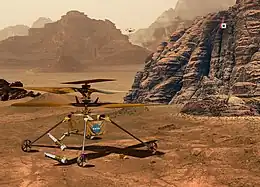
The idea of future Martian helicopters has been proposed. In March 2022, AeroVironment engineers, who previously created Ingenuity, presented the concept of a new helicopter with a payload of 280 g. A 90 g small manipulator arm with a two-fingered gripper and a self-propelled landing gear make it possible to use vehicles of this type instead of a fetch rover[133] to select sample tubes cases with samples collected by Perseverance.[134] At a briefing on September 15, 2022, NASA Planetary Science Division Director Laurie Gleizes confirmed her intention to use two of these helicopters.[135]
The choice of Ingenuity as the prototype for the intended pair of assembler helicopters was based on the impressive safety margin built into it by AeroVironment designers. In principle, even the limit of 100 landings for the high-wear shock absorbers of the chassis is sufficient to transfer all 43 sleeves. Multiple small payloads can be carried by these types of helicopters, deployed and re-deployed to various locations, to perform a variety of distributed and networked operations.[136]
Inertial navigation was one of the main challenges on Mars for the Ingenuity. The helicopter needs to show the ability to accurately follow the track it has already "mapped" on previously collected NAV frame sets and land at the takeoff point. In a future sample return mission, each cartridge case would require a pair of flights ending at the point of departure. Landing accuracy was an assigned task of Ingenuity's 31st flight.[137] The very thin atmosphere of Mars does not allow repeating the maneuvers and landing techniques of terrestrial helicopters.[138][31]
Mars Science Helicopter

Data collected by Ingenuity are intended to support the development of future helicopters capable of carrying larger payloads.[139][39][25][140]
Tributes to the Wright brothers
NASA and JPL officials described the first Mars Ingenuity helicopter flight as their "Wright Brothers moment", by analogy to the first successful powered airplane flight on Earth.[141][142] A small piece of the wing cloth from the Wright brothers' 1903 Wright Flyer is attached to a cable underneath Ingenuity's solar panel.[8] In 1969, Apollo 11's Neil Armstrong carried a similar Wright Flyer artifact to the Moon in the Lunar Module Eagle.
NASA named Ingenuity's first take-off and landing airstrip Wright Brothers Field, which the UN agency ICAO gave an airport code of JZRO for Jezero Crater,[143] and the drone itself a type designator of IGY, call-sign INGENUITY.[144][145][143]
Gallery
Audio
Flight videos
(video; 00:57; 19 April 2021)
(00:21; 22 April 2021)
(01:16; 25 April 2021)
(02:44; 30 April 2021)
(01:55; 4 September 2021)
Deployment sequence
Maps of flights
R210 is the rover position on sol 210;
H163
1, H174
2 and H193
3 means 1st, 2nd and 3rd landing sites of Ingenuity on the Field H on sols 163, 174 and 193 respectively
Images by Ingenuity
(23 April 2022)
Motion images
Self-portraits by Perseverance[lower-alpha 5]

(April 2021)
See also
- ARES – 2008 robotic Mars aircraft proposal
- Atmosphere of Mars – Less than 1% of the Earth's atmosphere pressure and primarily composed of carbon dioxide (95% CO2), molecular nitrogen (2.8%, N2) and argon (2% Ar)
- Coaxial rotors – Helicopter with two sets of rotor blades placed on top of each other
- Dragonfly – Robotic rotorcraft mission to Saturn's moon Titan, planned launch in 2027
- Exploration of Mars
- List of artificial objects on Mars
- List of firsts in aviation
- Sky-Sailor – 2004 proposal of a robotic Mars aircraft
- Solar panels on spacecraft
- Vega – The USSR space program that included the first atmospheric balloon flight on Venus, in 1985
- Collier Trophy – Presented to the Ingenuity team in 2022 for "the greatest achievement in aeronautics or astronautics in America during the preceding year"
- Mars Aerial and Ground Global Intelligent Explorer (MAGGIE) - Solar UAV plane with VTOL capabilites to land and recharge.[147]
Notes
- ↑ Flights 1, 2 and 14 are not seen because they include little, if any, horizontal movement.
- ↑ HiRISE's view of Ingenuity's fourth flight path paving the way for it to move to second airfield on its fifth flight
- ↑ All images taken by Ingenuity are from either its black-and-white downward-facing navigation camera[97] or from horizon-facing color camera;[98] landing legs are seen at the side edges of images
- ↑ Perseverance Rover wheels are clearly seen in top corners
- ↑ Only the self-portraits of Perseverance showing Ingenuity
References
- 1 2 3 4 5 6 7 8 9 10 11
 One or more of the preceding sentences incorporates text from this source, which is in the public domain: "Ingenuity Mars Helicopter Landing Press Kit" (PDF). NASA. January 2021. Archived (PDF) from the original on 18 February 2021. Retrieved 14 February 2021.
One or more of the preceding sentences incorporates text from this source, which is in the public domain: "Ingenuity Mars Helicopter Landing Press Kit" (PDF). NASA. January 2021. Archived (PDF) from the original on 18 February 2021. Retrieved 14 February 2021. - 1 2
 One or more of the preceding sentences incorporates text from this source, which is in the public domain: "Mars Helicopter". Mars.nasa.gov. NASA. Archived from the original on 16 April 2020. Retrieved 2 May 2020.
One or more of the preceding sentences incorporates text from this source, which is in the public domain: "Mars Helicopter". Mars.nasa.gov. NASA. Archived from the original on 16 April 2020. Retrieved 2 May 2020. - ↑ "Mars Lander Missions". NASA Goddard Institute for Space Studies. Retrieved 26 October 2021.
- 1 2 "NASA's Mars Helicopter: Small, Autonomous Rotorcraft To Fly On Red Planet" Archived 10 July 2018 at the Wayback Machine, Shubham Sharma, International Business Times, 14 May 2018
- 1 2
 One or more of the preceding sentences incorporates text from this source, which is in the public domain: "Mars Helicopter a new challenge for flight" (PDF). NASA. July 2018. Archived (PDF) from the original on 1 January 2020. Retrieved 20 July 2018.
One or more of the preceding sentences incorporates text from this source, which is in the public domain: "Mars Helicopter a new challenge for flight" (PDF). NASA. July 2018. Archived (PDF) from the original on 1 January 2020. Retrieved 20 July 2018. - ↑ Mars Rover Perseverance Set To Launch Drone. Today (American TV program). 24 March 2021. Retrieved 27 March 2021 – via YouTube.
- ↑ hang, Kenneth (23 March 2021). "Get Ready for the First Flight of NASA's Mars Helicopter – The experimental vehicle named Ingenuity traveled to the red planet with the Perseverance rover, which is also preparing for its main science mission". The New York Times. Retrieved 23 March 2021.
- 1 2 Johnson, Alana; Hautaluoma, Grey; Agle, DC (23 March 2021). "NASA Ingenuity Mars Helicopter Prepares for First Flight". NASA. Retrieved 23 March 2021.
- ↑ AFP Staff Writers (19 April 2021). "Ingenuity helicopter successfully flew on Mars: NASA". Mars Daily. ScienceDaily. Retrieved 19 April 2021.
- ↑ Hotz, Robert Lee (19 April 2021). "NASA's Mars Helicopter Ingenuity Successfully Makes Historic First Flight". Wall Street Journal. ISSN 0099-9660. Retrieved 19 April 2021.
- ↑ Palca, Joe (19 April 2021). "Success! NASA's Ingenuity Makes First Powered Flight On Mars". National Public Radio. Retrieved 19 April 2021.
- ↑ Wu, Daniel (2 June 2023). "NASA's Mars helicopter is somehow still flying — and playing hide-and-seek - Scientists thought Ingenuity would fail years ago. It's still flying, although NASA has to search for it occasionally". The Washington Post. Archived from the original on 2 June 2023. Retrieved 4 June 2023.
- ↑ "NASA Science – Mars 2020 Mission Communications". Mars.NASA.gov. 14 February 2022. Retrieved 14 February 2022.
- 1 2 3 Decision expected soon on adding helicopter to Mars 2020, Jeff Fout, SpaceNews 4 May 2018
- ↑ Chang, Kenneth (19 April 2021). "NASA's Mars Helicopter Achieves First Flight on Another World – The experimental Ingenuity vehicle completed the short but historic up-and-down flight on Monday morning". The New York Times. Archived from the original on 28 December 2021. Retrieved 19 April 2021.
- 1 2 3 Status 290.
- ↑ First Flight of the Ingenuity Mars Helicopter: Live from Mission Control. NASA. 19 April 2021. Retrieved 19 April 2021 – via YouTube.
- 1 2 @NASA (17 April 2021). "Encouraging news: #MarsHelicopter completed a full-speed spin test—an important milestone on our path to 1st flight" (Tweet). Retrieved 17 April 2021 – via Twitter.
- ↑ Mccurdy, Christen (17 April 2021). "Mars Ingenuity flight scheduled for Monday, NASA says". Mars Daily. ScienceDaily. Retrieved 18 April 2021.
- ↑ "NASA's Perseverance Captures Video, Audio of Fourth Ingenuity Flight". NASA's Mars Exploration Program. Retrieved 7 May 2021.
- ↑ Chang, Kenneth (30 April 2021). "NASA's Mars Helicopter Flies Again and Gets a New Mission – Ahead of a successful fourth flight, the agency announced that Ingenuity would continue to fly beyond its original month-long mission". The New York Times. Retrieved 30 April 2021.
- ↑ Strickland, Ashley (30 April 2021). "After fourth successful flight, Mars helicopter gets a new mission". Cnn.com. Retrieved 1 May 2021.
- ↑ Chang, Kenneth (23 June 2020). "Mars Is About to Have Its "Wright Brothers Moment" – As part of its next Mars mission, NASA is sending an experimental helicopter to fly through the red planet's thin atmosphere". The New York Times. Archived from the original on 23 June 2020. Retrieved 7 March 2021.
- ↑ Leone, Dan (19 November 2015). "Elachi Touts Helicopter Scout for Mars Sample-Caching Rover". SpaceNews. Archived from the original on 21 January 2016. Retrieved 20 November 2015.
- 1 2 3 4 5 6 7 8
 One or more of the preceding sentences incorporates text from this source, which is in the public domain: Mars Helicopter Technology Demonstrator Archived 1 April 2019 at the Wayback Machine J. (Bob) Balaram, Timothy Canham, Courtney Duncan, Matt Golombek, Håvard Fjær Grip, Wayne Johnson, Justin Maki, Amelia Quon, Ryan Stern, and David Zhu; American Institute of Aeronautics and Astronautics (AIAA) SciTech Forum Conference 8–12 January 2018 Kissimmee, Florida doi:10.2514/6.2018-0023
One or more of the preceding sentences incorporates text from this source, which is in the public domain: Mars Helicopter Technology Demonstrator Archived 1 April 2019 at the Wayback Machine J. (Bob) Balaram, Timothy Canham, Courtney Duncan, Matt Golombek, Håvard Fjær Grip, Wayne Johnson, Justin Maki, Amelia Quon, Ryan Stern, and David Zhu; American Institute of Aeronautics and Astronautics (AIAA) SciTech Forum Conference 8–12 January 2018 Kissimmee, Florida doi:10.2514/6.2018-0023 - 1 2 "NASA Extends Ingenuity Helicopter Mission". Mars Exploration Program. NASA. 15 March 2022.
- 1 2 3 4
 One or more of the preceding sentences incorporates text from this source, which is in the public domain: Generation of Mars Helicopter Rotor Model for Comprehensive Analyses Archived 1 January 2020 at the Wayback Machine, Witold J. F. Koning, Wayne Johnson, Brian G. Allan; NASA 2018
One or more of the preceding sentences incorporates text from this source, which is in the public domain: Generation of Mars Helicopter Rotor Model for Comprehensive Analyses Archived 1 January 2020 at the Wayback Machine, Witold J. F. Koning, Wayne Johnson, Brian G. Allan; NASA 2018 - ↑ "Ingenuity Spots Rover Tracks During Ninth Flight". NASA. 12 July 2021.
- 1 2 3 Preston Lerner (April 2019). "A Helicopter Dreams of Mars". Air & Space/Smithsonian. Retrieved 16 August 2021.
- ↑ J. Balaram and P. T. Tokumaru, "Rotorcrafts for Mars Exploration", in 11th International Planetary Probe Workshop, 2014, Bibcode 2014LPICo1795.8087B Balaram, J.; Tokumaru, P. T. (2014). "Rotorcrafts for Mars Exploration". 11th International Planetary Probe Workshop. 1795: 8087. Bibcode:2014LPICo1795.8087B. Archived from the original on 17 February 2021. Retrieved 29 October 2020.
- 1 2 3 4 Benjamin T. Pipenberg, Matthew Keennon, Jeremy Tyler, Bart Hibbs, Sara Langberg, J. (Bob) Balaram, Håvard F. Grip and Jack Pempejian, "Design and Fabrication of the Mars Helicopter Rotor, Airframe, and Landing Gear Systems Archived 21 February 2021 at the Wayback Machine", American Institute of Aeronautics and Astronautics (AIAA), SciTech Forum Conference; 7–11 January 2019, San Diego, California
- ↑ Berger, Eric (24 May 2016). "Four wild technologies lawmakers want NASA to pursue". ARS Technica. Retrieved 24 May 2016.
- 1 2 3 Clarke, Stephen (14 May 2018). "Helicopter to accompany NASA's next Mars rover to Red Planet". Spaceflight Now.
- ↑ Dubois, Chantelle (29 November 2017). "Drones on Mars? NASA Projects May Soon Use Drones for Space Exploration". All About Circuits. Archived from the original on 7 December 2017. Retrieved 14 January 2018.
- ↑ Beutel, Allard (15 April 2015). "NASA Announces Mars 2020 Rover Payload to Explore the Red Planet". NASA. Retrieved 7 September 2022.
- ↑ Grush, Loren (11 May 2018). "NASA is sending a helicopter to Mars to get a bird's-eye view of the planet". The Verge. Retrieved 7 September 2022.
- ↑ NASA Mars exploration efforts turn to operating existing missions and planning sample return, Jeff Foust, SpaceNews, 23 February 2018
- ↑ NASA to decide soon whether flying drone will launch with Mars 2020 rover Archived 21 February 2021 at the Wayback Machine Stephen Clark Spaceflight Now 15 March 2018
- 1 2 3
 One or more of the preceding sentences incorporates text from this source, which is in the public domain: "Mars Helicopter to Fly on NASA's Next Red Planet Rover Mission". NASA. 11 May 2018. Archived from the original on 11 May 2018.
One or more of the preceding sentences incorporates text from this source, which is in the public domain: "Mars Helicopter to Fly on NASA's Next Red Planet Rover Mission". NASA. 11 May 2018. Archived from the original on 11 May 2018. - ↑
 One or more of the preceding sentences incorporates text from this source, which is in the public domain: Agle, AG; Johnson, Alana (28 March 2019). "NASA's Mars Helicopter Completes Flight Tests". NASA. Archived from the original on 29 March 2019. Retrieved 28 March 2019.
One or more of the preceding sentences incorporates text from this source, which is in the public domain: Agle, AG; Johnson, Alana (28 March 2019). "NASA's Mars Helicopter Completes Flight Tests". NASA. Archived from the original on 29 March 2019. Retrieved 28 March 2019. - ↑
 One or more of the preceding sentences incorporates text from this source, which is in the public domain.
One or more of the preceding sentences incorporates text from this source, which is in the public domain. - ↑
 One or more of the preceding sentences incorporates text from this source, which is in the public domain: "Mars 2020 Perseverance Launch Press Kit" (PDF). NASA. 24 June 2020. Archived (PDF) from the original on 21 July 2020. Retrieved 20 August 2020.
One or more of the preceding sentences incorporates text from this source, which is in the public domain: "Mars 2020 Perseverance Launch Press Kit" (PDF). NASA. 24 June 2020. Archived (PDF) from the original on 21 July 2020. Retrieved 20 August 2020. - 1 2 3 First Flight on Another Planet!. Veritasium. 10 August 2019. Archived from the original on 28 July 2020. Retrieved 3 August 2020 – via YouTube.
- ↑ Status 289.
- 1 2 3 Ingenuity Mars Helicopter Preflight Briefing (press conference livestreamed on YouTube). NASA Jet Propulsion Laboratory. 9 April 2021.
- ↑
 One or more of the preceding sentences incorporates text from this source, which is in the public domain: Hautaluoma, Grey; Johnson, Alana; Agle, D.C. (29 April 2020). "Alabama High School Student Names NASA's Mars Helicopter". NASA. Archived from the original on 30 April 2020. Retrieved 29 April 2020.
One or more of the preceding sentences incorporates text from this source, which is in the public domain: Hautaluoma, Grey; Johnson, Alana; Agle, D.C. (29 April 2020). "Alabama High School Student Names NASA's Mars Helicopter". NASA. Archived from the original on 30 April 2020. Retrieved 29 April 2020. - ↑
 One or more of the preceding sentences incorporates text from this source, which is in the public domain: Agle, D.C.; Cook, Jia-Rui; Johnson, Alana (29 April 2020). "Q&A with the Student Who Named Ingenuity, NASA's Mars Helicopter". NASA. Archived from the original on 4 June 2020. Retrieved 29 April 2020.
One or more of the preceding sentences incorporates text from this source, which is in the public domain: Agle, D.C.; Cook, Jia-Rui; Johnson, Alana (29 April 2020). "Q&A with the Student Who Named Ingenuity, NASA's Mars Helicopter". NASA. Archived from the original on 4 June 2020. Retrieved 29 April 2020. - 1 2
 One or more of the preceding sentences incorporates text from this source, which is in the public domain: Mars Helicopter Scout. video presentation at Caltech
One or more of the preceding sentences incorporates text from this source, which is in the public domain: Mars Helicopter Scout. video presentation at Caltech - 1 2 3
 One or more of the preceding sentences incorporates text from this source, which is in the public domain: "Mars Helicopter Fact Sheet" (PDF). NASA. February 2020. Archived (PDF) from the original on 22 March 2020. Retrieved 2 May 2020.
One or more of the preceding sentences incorporates text from this source, which is in the public domain: "Mars Helicopter Fact Sheet" (PDF). NASA. February 2020. Archived (PDF) from the original on 22 March 2020. Retrieved 2 May 2020. - ↑
 One or more of the preceding sentences incorporates text from this source, which is in the public domain: "Astronomy Picture of the Day". NASA. 2 March 2021. Retrieved 4 March 2021.
One or more of the preceding sentences incorporates text from this source, which is in the public domain: "Astronomy Picture of the Day". NASA. 2 March 2021. Retrieved 4 March 2021. - ↑ "NASA begins search for ancient life on Mars after arrival of Perseverance, Ingenuity spacecrafts". www.cbsnews.com. 9 May 2021. Retrieved 7 September 2022.
- ↑ Chang, Kenneth (12 May 2018). "A Helicopter on Mars? NASA Wants to Try". The New York Times. Archived from the original on 12 May 2018. Retrieved 12 May 2018.
- ↑ Gush, Loren (11 May 2018). "NASA is sending a helicopter to Mars to get a bird's-eye view of the planet – The Mars Helicopter is happening". The Verge. Archived from the original on 6 December 2020. Retrieved 11 May 2018.
- ↑ Review on space robotics: Toward top-level science through space exploration Archived 21 February 2021 at the Wayback Machine Y. Gao, S. Chien – Science Robotics, 2017
- ↑
 One or more of the preceding sentences incorporates text from this source, which is in the public domain: "NASA's Mars Helicopter Reports In". NASA. 19 February 2021. Retrieved 23 February 2021.
One or more of the preceding sentences incorporates text from this source, which is in the public domain: "NASA's Mars Helicopter Reports In". NASA. 19 February 2021. Retrieved 23 February 2021. - ↑ Ianson, Eric; Meyer, Michael (3 May 2022). Explore Mars, Mars Exploration Program Briefing to MEPAG (PDF) (Report). NASA. Retrieved 28 January 2023.
- 1 2 Status 293.
- ↑ Status 294.
- 1 2 3 Status 297.
- ↑ Status 287.
- ↑ Status 288.
- ↑ Status 301.
- 1 2 Status 313.
- 1 2 "How NASA Designed a Helicopter That Could Fly Autonomously on Mars". IEEE Spectrum. 17 February 2021. Archived from the original on 19 February 2021. Retrieved 19 February 2021.
- ↑ Metcalfe, Tom (12 February 2021). "First 'space helicopter' set to take to Martian skies". NBC News. Retrieved 11 October 2021.
- ↑ Finley, Klint (14 April 2021). "Open Source on Mars: Community powers NASA's Ingenuity Helicopter". GitHub. Retrieved 11 October 2021.
- ↑ Status 295.
- ↑ Status 298.
- ↑ Status 305.
- ↑ Status 314.
- 1 2 3 Status 321.
- ↑ Status 299.
- ↑ Status 318.
- 1 2 3 4 5 Status 308.
- 1 2 Status 316.
- 1 2 Chahat, Nacer; Miller, Joshua; Decrossas, Emmanuel; McNally, Lauren; Chase, Matthew; Jin, Curtis; Duncan, Courtney (December 2020). "The Mars Helicopter Telecommunication Link: Antennas, Propagation, and Link Analysis". IEEE Antennas and Propagation Magazine. 62 (6): 12–22. Bibcode:2020IAPM...62f..12C. doi:10.1109/MAP.2020.2990088. S2CID 219472515.
- ↑ Chahat, Nacer; Chase, Matt; Lazaro, Austin; Gupta, Gaurangi; Duncan, Courtney (22 November 2023). "Enhancing Communication Link Predictions for Ingenuity Mars Helicopter Mission with the Parabolic Equation Method". IEEE Transactions on Antennas and Propagation: 1. doi:10.1109/TAP.2023.3333433. S2CID 265392941.
- ↑ "Season 5, Episode 2: Talking to Ingenuity and Other Space Robots - NASA". Retrieved 1 December 2023.
- ↑ "Space Foundation Selects NASA JPL Ingenuity Mars Helicopter Flight Team To Receive 2021 John L. 'Jack' Swigert Jr. Award for Space Exploration". Space Foundation. 9 June 2021. Retrieved 16 June 2021.
- ↑ "The NASA/JPL Ingenuity Mars Helicopter Team Awarded the 2021 Robert J. Collier Trophy" (PDF).
- ↑ mars.nasa.gov. "NASA's Mars Helicopter Team Members With Collier Trophy". NASA Mars Exploration. Retrieved 17 October 2022.
- ↑ Ackerman, Evan (8 December 2021). "Mars Helicopter Is Much More Than a Tech Demo". IEEE Spectrum. Retrieved 17 October 2022.
- ↑ "NASAFacts Mars 2020/Perseverance" (PDF).
- 1 2 Foust, Jeff (4 May 2018). "Decision expected soon on adding helicopter to Mars 2020". SpaceNews. Retrieved 17 October 2022.
- ↑ Status 392.
- 1 2 "Mars Exploration Program Presentation to PAC" (PDF). 14 June 2021.
- 1 2 Status 450.
- 1 2 Status 441.
- ↑ September 2017, Tim Sharp 12 (12 September 2017). "Mars' Atmosphere: Composition, Climate & Weather". Space.com. Retrieved 10 March 2021.
{{cite web}}: CS1 maint: numeric names: authors list (link) - ↑ Bachman, Justin (19 April 2021). "Why flying a helicopter on Mars is a big deal". phys.org. Retrieved 21 April 2021.
Indeed, flying close to the surface of Mars is the equivalent of flying at more than 87,000 feet on Earth, essentially three times the height of Mount Everest, NASA engineers said. The altitude record for a helicopter flight on Earth is 41,000 feet.
- 1 2 "6 Things to Know About NASA's Mars Helicopter on Its Way to Mars". NASA Jet Propulsion Laboratory (JPL). 21 January 2021. Retrieved 21 January 2021.
- ↑ Grip, Håvard Fjær; Lam, Johnny N. (2019). "Flight Control System for NASA's Mars Helicopter" (PDF). NASA/JPL. Retrieved 16 April 2021.
- ↑ NASA's Ingenuity Mars Helicopter's Next Steps. Media briefing. NASA/JPL. 30 April 2021. Retrieved 30 April 2021 – via YouTube.
- ↑ Matthies, Bayard; Delaune, Conway (2019). "Vision-Based Navigation for the NASA Mars Helicopter". AIAA Scitech 2019 Forum (1411): 3. doi:10.2514/6.2019-1411. ISBN 978-1-62410-578-4. S2CID 86460806.
- ↑ On Mars, the amazing design of the radio link between Ingenuity and the Perseverance rover (in French). Université de Rennes. 10 April 2021. Event occurs at 00:07:27 – via YouTube.
- ↑ Jet Propulsion Laboratory (26 August 2021). "NASA's Ingenuity Helicopter sees potential Martian "road" ahead". SciTechDaily. Retrieved 30 August 2021.
- 1 2 3 "Raw Images From Ingenuity Helicopter". NASA. 30 April 2021. Retrieved 10 May 2021. (NAV images)
- 1 2 "Raw Images From Ingenuity Helicopter". NASA. 30 April 2021. Retrieved 10 May 2021. (RTE images)
- 1 2 "Ingenuity's First Color Snap". NASA. 5 April 2021. Retrieved 8 April 2021.
- 1 2 "Images from the Mars Perseverance Rover". Mars.nasa.gov. Retrieved 17 February 2022.
- ↑ Status 420.
- 1 2 Status 334.
- ↑ @NASAJPL (5 July 2021). "#MarsHelicopter pushes its Red Planet limits. 🚁The rotorcraft completed its 9th and most challenging flight yet, f…" (Tweet). Retrieved 5 July 2021 – via Twitter.
- ↑ "NASA's Mars Helicopter Survives First Cold Martian Night on Its Own". Nasa Mars Website.
- ↑
 One or more of the preceding sentences incorporates text from this source, which is in the public domain: Agle, D.C.; Hautaluoma, Gray; Johnson, Alana (23 June 2020). "How NASA's Mars Helicopter Will Reach the Red Planet's Surface". NASA. Archived from the original on 19 February 2021. Retrieved 23 February 2021.
One or more of the preceding sentences incorporates text from this source, which is in the public domain: Agle, D.C.; Hautaluoma, Gray; Johnson, Alana (23 June 2020). "How NASA's Mars Helicopter Will Reach the Red Planet's Surface". NASA. Archived from the original on 19 February 2021. Retrieved 23 February 2021. - ↑ Griffith, Andrew (8 April 2021). "NASA Unlocks Mars Helicopter's Rotor Blades Ahead Of Pioneering Ingenuity Flight". The Independent. Retrieved 8 April 2021.
- ↑ Bartels, Meghan (8 April 2021). "Mars helicopter Ingenuity unlocks its rotor blades to prepare for 1st flight on Red Planet". Space.com. Retrieved 8 April 2021.
- ↑ "Ingenuity Begins to Spin Its Blades". NASA's Mars Exploration Program. NASA. 9 April 2021.
- ↑ @NASAJPL (9 April 2021). "🎶Wiggle, wiggle, wiggle 🎶 With just a little bit of swing, the #MarsHelicopter has moved its blades & spun to 50…" (Tweet). Retrieved 18 April 2021 – via Twitter.
- ↑ Latifiyan, Pouya (April 2021). "Space Telecommunications, how?". Take off. Tehran: Civil Aviation Technology College. 1: 15 – via Persian.
- ↑ Status 291.
- ↑ Status 292.
- 1 2 3 "NASA's Ingenuity Helicopter to Begin New Demonstration Phase".
- ↑ "The Long Wait - NASA". Mars Helicopter Tech Demo. Retrieved 11 November 2023.
- ↑ "NASA Helicopter Marks 6 Months on Mars, Is Still Flying High - ExtremeTech". www.extremetech.com. 8 September 2021. Retrieved 7 September 2022.
- ↑ "Breaking: Mars Helicopter Is Now A Fully Operational Partner Of Perseverance". IFLScience. 30 April 2021. Retrieved 30 April 2021.
- ↑ Gohd, Chelsea (30 April 2021). "NASA extends Mars helicopter Ingenuity's high-flying mission on Red Planet". Space.com. Retrieved 10 June 2021.
- ↑ mars.nasa.gov. "Location Map for Perseverance Rover - NASA". mars.nasa.gov. Retrieved 26 September 2023.
- 1 2 "Ingenuity Is So Good, NASA's Mars Helicopter Mission Just Got an Exciting Update". Science Alert. 6 September 2021. Retrieved 6 September 2021.
- ↑ "Solar Conjunction | Mars in our Night Sky". NASA's Mars Exploration Program. Retrieved 18 August 2021.
- ↑ "NASA's Mars Fleet Lies Low As Sun Moves Between Earth and Red Planet". NASA. 28 September 2021. Retrieved 28 September 2021.
- ↑ "The 10 flights of NASA's Ingenuity Mars helicopter in one chart". Business Insider Australia. 29 July 2021. Retrieved 30 August 2021.
- ↑ "After Six Months On Mars, NASA's Tiny Helicopter Is Still Flying High". NDTV. 5 September 2021. Retrieved 5 September 2021.
- ↑ "NASA's eventual farewell to tiny Mars helicopter could be emotional".
- ↑ Status 373.
- 1 2 Status 382.
- ↑ Status 379.
- ↑ Status 385.
- ↑ "Planetary Science and Astrobiology Decadal Survey 2023-2032".
- ↑ Foust, Jeff (27 July 2022). "NASA and ESA remove rover from Mars Sample Return plans". SpaceNews. Retrieved 17 October 2022.
- ↑ Pipenberg, Benjamin T.; Langberg, Sara A.; Tyler, Jeremy D.; Keennon, Matthew T. (March 2022). "Conceptual Design of a Mars Rotorcraft for Future Sample Fetch Missions". 2022 IEEE Aerospace Conference (AERO). pp. 01–14. doi:10.1109/AERO53065.2022.9843820. ISBN 978-1-6654-3760-8. S2CID 251473077.
- ↑ News Briefing: NASA's Perseverance Mars Rover Investigates Geologically Rich Area, 15 September 2022, retrieved 17 October 2022
- ↑ Status 417.
- ↑ Status 398.
- ↑ "Inside Unmanned Systems: Inside the Ingenuity Helicopter" (PDF).
- ↑ "Mars Science Helicopter". spacenews.com. Space News. 24 June 2021. Retrieved 24 June 2021.
- ↑
 One or more of the preceding sentences incorporates text from this source, which is in the public domain: "Mars Helicopter a new challenge for flight" (PDF). NASA. July 2018. Archived (PDF) from the original on 1 January 2020. Retrieved 9 August 2018.
One or more of the preceding sentences incorporates text from this source, which is in the public domain: "Mars Helicopter a new challenge for flight" (PDF). NASA. July 2018. Archived (PDF) from the original on 1 January 2020. Retrieved 9 August 2018. - ↑ Gorman, Steve (19 April 2021). "NASA scores Wright Brothers moment with first helicopter flight on Mars". Reuters. Retrieved 21 April 2021.
- ↑ Harwood, William (19 April 2021). "NASA's Ingenuity helicopter makes maiden flight on Mars in a "Wright brothers moment"". CBS News. Retrieved 21 April 2021.
- 1 2 "NASA's Ingenuity Mars Helicopter Succeeds in Historic First Flight". Mars Exploration Program. NASA. 19 April 2021. Retrieved 19 April 2021.
- ↑ Amos, Jonathan (19 April 2021). "NASA successfully flies small helicopter on Mars". BBC.
- ↑ Strickland, Ashley (19 April 2021). "NASA's Mars helicopter Ingenuity successfully completed its historic first flight". CNN. Retrieved 19 April 2021.
- ↑ Chang, Kenneth (27 April 2022). "NASA Sees 'Otherworldly' Wreckage on Mars With Ingenuity Helicopter - The debris was part of the equipment that helped the Perseverance mission safely land on the red planet in 2021". The New York Times. Retrieved 28 April 2022.
- ↑ https://www.nasa.gov/general/mars-aerial-and-ground-global-intelligent-explorer/
Status reports
- Bob Balaram (19 March 2021). "How is the Weather on Mars?". Status #287. NASA/JPL. Retrieved 25 July 2021.
- Bob Balaram (2 April 2021). "It's Cold on Mars". Status #288. NASA/JPL.
- "When Should Ingenuity Fly?". Status #289. NASA/JPL. 8 April 2021. Retrieved 25 July 2021.
- "Work Progresses Toward Ingenuity's First Flight on Mars". Status #290. NASA/JPL. 12 April 2021. Retrieved 25 July 2021.
- "Mars Helicopter Flight Delayed to No Earlier than April 14". Status #291. NASA/JPL. 10 April 2021. Retrieved 25 July 2021.
- Ingenuity Flight Team (16 April 2021). "Working the Challenge: Two Paths to First Flight on Mars". Status #292. NASA/JPL. Retrieved 25 July 2021.
- MiMi Aung (17 April 2021). "Why We Choose to Try Our First Helicopter Flight on Monday". Status #293. NASA/JPL. Retrieved 25 July 2021.
- MiMi Aung (21 April 2021). "We're Getting Ready for Ingenuity's Second Flight". Status #294. NASA/JPL. Retrieved 25 July 2021.
- Håvard Grip (23 April 2021). "We Are Prepping for Ingenuity's Third Flight Test". Status #295. NASA/JPL.
- "Mars Helicopter's Flight Four Rescheduled". Status #296. NASA/JPL. 29 April 2021. Retrieved 25 July 2021.
- MiMi Aung (30 April 2021). "Ingenuity Completes Its Fourth Flight". Status #297. NASA/JPL. Retrieved 25 July 2021.
- Håvard Grip (30 April 2021). "What We're Learning About Ingenuity's Flight Control and Aerodynamic Performance". Status #298. NASA/JPL. Retrieved 25 July 2021.
- Josh Ravich (6 May 2021). "Why Ingenuity's Fifth Flight Will Be Different". Status #299. NASA/JPL. Retrieved 25 July 2021.
- Bob Balaram, Jeremy Tyler (10 May 2021). "Keeping Our Feet Firmly on the Ground". Status #301. NASA/JPL. Retrieved 25 July 2021.
- "Plans Underway for Ingenuity's Sixth Flight". Status #302. NASA/JPL. 19 May 2021. Retrieved 25 July 2021.
- Håvard Grip (27 May 2021). "Surviving an In-Flight Anomaly: What Happened on Ingenuity's Sixth Flight". Status #305. NASA/JPL. Retrieved 25 July 2021.
- "Ingenuity Flight 7 Preview". Status #306. NASA/JPL. 4 June 2021. Retrieved 25 July 2021.
- Teddy Tzanetos (25 June 2021). "Flight 8 Success, Software Updates, and Next Steps". Status #308. NASA/JPL. Retrieved 25 July 2021.
- Håvard Grip & Bob Balaram (2 July 2021). "We're Going Big for Flight 9". Status #313. NASA/JPL. Retrieved 25 July 2021.
- Håvard Grip and Ken Williford (7 July 2021). "Flight 9 Was a Nail-Biter, but Ingenuity Came Through With Flying Colors". Status #314. NASA/JPL. Retrieved 25 July 2021.
- Teddy Tzanetos (23 July 2021). "Aerial Scouting of 'Raised Ridges' for Ingenuity's Flight 10". Status #316. NASA/JPL. Retrieved 25 July 2021.
- Josh Ravich (4 August 2021). "North-By-Northwest for Ingenuity's 11th Flight". Status #318. NASA/JPL. Retrieved 5 August 2021.
- Teddy Tzanetos (15 August 2021). "Better By the Dozen – Ingenuity Takes on Flight 12". Status #321. NASA/JPL. Retrieved 15 August 2021.
- Teddy Tzanetos, Håvard Grip (3 September 2021). "Lucky 13 – Ingenuity to Get Lower for More Detailed Images During Next Flight". Status #329. NASA/JPL. Retrieved 3 September 2021.
- Håvard Grip (15 September 2021). "Flying on Mars Is Getting Harder and Harder". Status #334. NASA/JPL. Retrieved 15 September 2021.
- Jaakko Karras (28 September 2021). "2,800 RPM Spin a Success, but Flight 14 Delayed to Post Conjunction". Status #336. NASA/JPL. Retrieved 28 September 2021.
- Teddy Tzanetos (10 October 2021). "Flight 14 Successful". Status #341. NASA/JPL. Retrieved 25 November 2021.
- Teddy Tzanetos (5 November 2021). "Flight #15 — Start of the Return Journey". Status #343. NASA/JPL. Retrieved 25 November 2021.
- Joshua Anderson (16 November 2021). "Flight 16 — Short Hop to the North". Status #346. NASA/JPL. Retrieved 25 November 2021.
- Gerik Kubiak (2 December 2021). "Flight 17 — Heading North Into Séítah". Status #349. NASA/JPL.
- Teddy Tzanetos (7 December 2021). "Flight 17 – DiscoveringLimits". Status #350. NASA/JPL.
- Jaakko Karras (23 February 2022). "Dusty Flight 19 Completed and Looking Ahead to Flight 20". Status #366. NASA/JPL. Retrieved 27 February 2022.
- Morrell, Ben (5 April 2022). "Balancing Risks in the 'Séítah' Region - Flight 24". Status #373. NASA. Retrieved 6 April 2022.
- Agle, David (6 May 2022). "NASA's Ingenuity in Contact With Perseverance Rover After Communications Dropout" (Status379). Status #379. NASA. Retrieved 8 May 2022.
- Tzanetos, Teddy (27 May 2022). "Ingenuity Adapts for Mars Winter Operations". Status #382. NASA.
- Grip, Håvard (6 June 2022). "Keeping Our Sense of Direction: Dealing With a Dead Sensor". Status #385. NASA. Retrieved 14 June 2022.
- mars.nasa.gov. "Ingenuity Postpones Flights Until August". Status #392. Retrieved 17 October 2022.
- Teddy Tzanetos (19 August 2022). "Ingenuity Team Spun Up for Upcoming Flight 30". Status #398. NASA. Retrieved 9 May 2023.
- Bob Balaram (14 November 2022). "Mars Helicopters - The 4R's". Status #417. NASA. Retrieved 9 May 2023.
- Joshua Anderson. "Flight 34 Was Short But Significant - NASA". Status #420. Retrieved 24 November 2022.
- Travis Brown (14 February 2023). "Perseverance's Four-Legged Companion is Ready". Status #441. Retrieved 31 March 2023.
- Travis Brown (23 March 2023). "The Race Is On". Status #450. Retrieved 5 May 2023.
External links
- NASA Mars Helicopter webpage
- NASA Mars Helicopter flight log
- Mars Helicopter Technology Demonstrator. (PDF) – The key design features of the prototype drone.
- First Video of NASA's Ingenuity helicopter in flight – via YouTube.
- Perseverance Route Map – including the flight tracks of Ingenuity
- Explore Mars
- AIAA Book Planetary Exploration with Ingenuity and Dragonfly
- source code of program behind Ginny – NASA GitHub page


.jpg.webp)

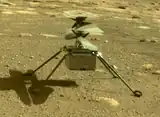



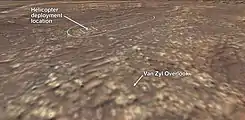






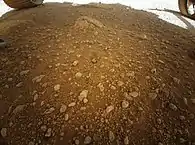
















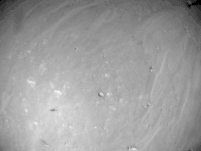





.gif)
.jpg.webp)

.jpg.webp)
.jpg.webp)
